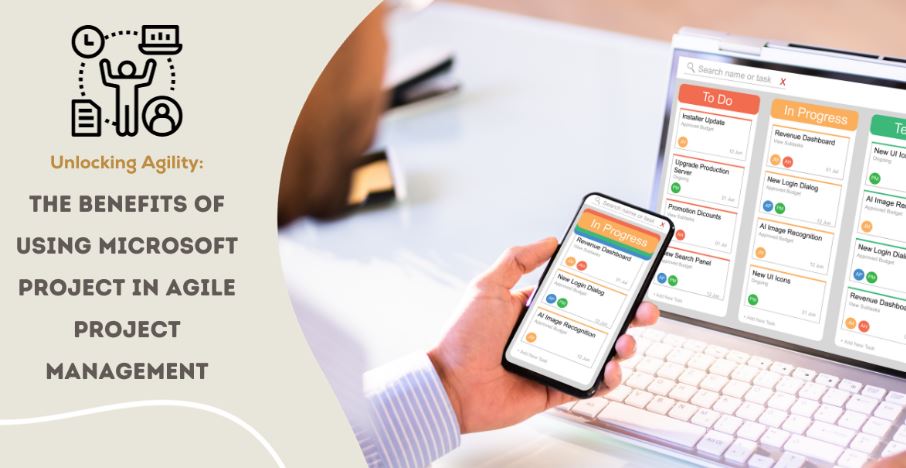Over the past two years, research indicates that the average amount of after-hour work has increased by 28% as of early 2022. Adapting to these new work pressures, it is crucial to utilize project management tools that support flexible agile methods.
One tool that can help is Microsoft Project. It seamlessly connects with other Microsoft 365 apps people already use. This saves time while offering better teamwork, flexibility to handle shifting needs, and visibility over work. Let’s look at some of the big benefits Microsoft Project provides for working in agile ways.
Enhanced Collaboration and Integration
With a recent 148% increase in Microsoft Teams meetings, easy collaboration has become crucial. Microsoft Project makes it simple to bring new team members onto projects and lets everyone edit tasks together in real time.
Its familiar look encourages teammates to actively take part in planning and updates, even if they’ve never used advanced project software before.
Support for Flexible Work Needs
Surveys show employees value workplace flexibility a lot – almost as much as 9% of their pay! Microsoft Project delivers options to match different needs and styles of working. Choose from classic calendar and Gantt views more easily or leverage newer agile-style digital boards and charts if that’s better for your projects.
Deep Ties to Microsoft 365 Apps
Microsoft Project also connects tightly with Microsoft 365 apps like Outlook, SharePoint, Teams and more that people use daily. Power BI analytics show organizations rely heavily on these apps for collaborating and accessing information.
Building on what employees already adopt and know saves ramp-up time and headaches. For example, you can connect Project tasks straight to SharePoint action lists for complete visibility without jumping between programs.
Built-In Teams Integration
Microsoft Teams has its own features to enable project management directly too. This lets teams execute agile sprints smoothly in Teams without extensive new software training. But Microsoft Project takes it a step further with pre-built integration to centralize project data across both tools. Teams get the straightforward planning and access of Teams combined with robust scheduling, workloads and reporting powered by Project. Not only that, giant companies believe in Singapore corporate training which is the best of both worlds!
Strong Visibility Across the Portfolio
Microsoft Project delivers a visual, interactive roadmap to help you optimize resources across programs and multiple projects simultaneously. The Timeline view provides a holistic picture by mapping dependencies between tasks, summary tasks, and milestones across workstreams6. This makes it easier to identify delivery risks and schedule changes before they escalate.
Why Not Having Agile Software Causes Major Headaches
An increasing number of teams are adopting the agile approach for project management. Agile breaks big goals into smaller chunks and has short iterations called sprints rather than long, rigid plans. This flexibility helps teams adjust quicker.
Lacking the appropriate agile-focused software, these advantages disappear quickly. Relying on basic tools like email and spreadsheets makes handling agile projects a major pain. A lot of people have a tough time getting familiar with agile project management software when they are new to the corporate world. In these cases, our team noticed that Acuity Training’s Project training course or something similar to it can help.
No Single Source of Truth
In agile, information changes rapidly as teams complete sprint goals and take on emerging tasks based on learnings and feedback. When this living data is scattered across inbox updates, 25 versions of the project spreadsheet, chats, etc there’s no reliable source of truth. Nobody has full visibility which makes things get missed. Without agile software to store evolving plans, documentation, needs, and results in one place, confusion spreads fast.
Lost Transparency Around Progress
Understanding what got done each sprint and where teams stand overall is critical in agile. But without dedicated software, progress visibility gets lost quick. Traditional reporting through lengthy status updates doesn’t cut it. Email trails provide limited snapshots. Agile software has boards, reports, charts and tools explicitly designed to capture agile progress in near real-time. This allows smarter steering of priorities and resources. Lacking transparency causes misalignment.
Difficulty Adapting and Adjusting
Changing priorities quickly is also vital in agile frameworks as learnings happen. But clunky manuals processes make any pivots painfully hard. Imagine trying to update tasks, dependencies, and workloads across multiple Excel sheets, Gantt chart slides, and project plans! Having an agile management system that’s nimble not only prevents logistical nightmares, but also helps teams stay more motivated than feeling chained to outdated plans.
Metrics and Insights Falling Short
Advanced analytics should empower agile improvements by connecting strategy to outcomes. However, spreadsheets have major limitations around crunching different data streams in flexible ways. Email and status meetings provide fragmented qualitative insights at best.
Without properly capturing metrics like velocity, flow efficiency, quality scores etc it’s impossible to pinpoint issues, identify trends or quantify progress at the level agile demands.
Clearly, not using purpose-built agile software severely undermines all the core agile pillars of transparency, flexibility and inspection. Additionally, disjointed data means decisions happens based on opinions rather than facts – a huge risk. Relying just on standard tools guarantees frustration, delays, and half-measures!
Addressing Common Questions
How can Microsoft Project help agile teams?
Even though agile teams work in quick sprints instead of big, long plans, Microsoft Project has features specifically to help track agile projects. Teams can add sprints, create agile boards to view tasks and progress in one spot, organize backlogs of work, and more. Reports even show agile-specific data like burndown charts. Microsoft Project helps keep all the dynamic elements of agile projects together.
What are boards in Microsoft Project?
Boards give agile teams a simple, visual way to view what user stories or requirements are coming up to work on, which are actively being developed in the current sprint, and which are done. Moving sticky notes on the digital board is an easy way to manage the changing agile workflow compared to emails and spreadsheets.
How does Microsoft Project help with agile reporting?
Reporting on progress is make-or-break for agile success. Microsoft Project offers pre-built reports with agile metrics that would be extremely manual to create otherwise, like sprint burndown charts, velocity tracking over sprints, and story planninganalysis. Automated reports save teams tons of time while giving the insights they need.
Final Thoughts
With powerful collaboration capabilities, flexible delivery options, and deep integration with Microsoft 365, Microsoft Project unlocks greater agility in project execution.
Microsoft Project provides robust scheduling, an interactive overview of cross-project dependencies, and alignment between key platforms, setting your teams up for success. To boost productivity across dispersed teams, Microsoft Project is an invaluable addition for organizations embracing agile at scale.



